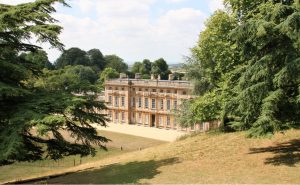I’m so glad I made the drive to Winchester. I had been before, but I couldn’t remember anything of this city. And oh, how I wished I had kept a blog as a kid (maybe a diary, blogging didn’t exist back then)! You could say I was spoilt as a kid; aren’t all kids these days? Not with the latest gadgets or fashionable label. I was spoilt by my parent’s passion to show me not only the world but the country which I call home. It’s with slight sadness of heart that I didn’t appreciate the efforts they made then as much as I would have now.
Winchester was once the capital of this land. This medieval, cathedral city has an abundance of incredible buildings and has history etched all over it. My visit wasn’t long enough, nor did it do it full justice. I did not see it all. Oh, how that disappointment of not seeing everything has already whetted my appetite for a return visit. The city is surely a must see for anyone who lives in England or wants to visit these shores. Not too far from central London or the southern coast, its development at this location can be understood. It became a Saxon capital and a powerful base for bishops. It also plays host to two of this country’s mystical characters – Alfred the great and Arthur and his knights of the round table.
On arrival, I quickly left my car and headed on foot in the direction of the cathedral. Why not, I thought, as I had done no planning or research. Why not just get lost and explore? Immediately I was captivated by the wonderful architecture that is spread all over the city. After capturing a charming pub with oak and white washed walls bathed in glorious autumn sunshine, I crossed the charming river Itchen. Rumour has this was the inspiration to John Keats ‘Ode to Autumn’. It was by chance I noticed a National Trust property on the bridge (a mill) and immediately marched in. It wasn’t my intention to visit a National Trust place today, so a quick peep before leaving in search of other sights was complete in no time.

Straight after leaving the river, the statue to Alfred the Great casts its watch over the city. A sword and not a wand is in his hand. He looks directly up the High Street, and what was described as the oldest high street of the land in a visit to a museum. His statue is as old as the building to his left. The guildhall attracts you to the brighter side of the street. A look in it its doorway distracts you for a little while. But wait! In search of more than a doorway, I stroll off in search of better things. Not much further up the street, a left turn was made through one of the 5 gateways in the walls that once guarded the city (not much left now) and towards the cathedral.
There it was, a 11th century masterpiece, one of Europe’s longest. To say I wasn’t impressed on first view is an understatement! Crowds, enticed to the local lawns for entertainment, were distracted from an interest in the building. Who could blame them, for on the outside it is unremarkable; not one of England’s finest. Taking an inquisitive step inside changes all of that and confirms that truthful saying that beauty is only skin deep. I stood in amazement first of all at the sheer size of this incredible building. I felt so small and lost in such a vast space. After picking up my jaw off the floor I spent my time taking those customary pictures. Every step seemed to discover a fresh, mind-blowing view. I feel that I could have spent all day in there.

I was sad to leave especially as the organist was enticing me to stay with the pleasant sounds he generated. Outside, the amazing autumn sunshine was waving its magical light all over the city. My meanderings took me off the beaten track – as they always do – in search of that amazing discovery. It led me to two things. Firstly, a church that had been converted to flats – an epitome of how religion is portrayed in this ever-dysfunctional modern era. The second discovery was, after getting lost around the converted barracks which have now been converted to flats, the Great Hall. References to King Arthur and knights of the round table were a thing of childhood imagination. There is a round table mounted high up on the wall of this 13th century building. Sadly, this was closed to me due to an event. My fascination with this myth will ensure that this is ticked off on my next visit.
A wander to the top of town seemed like a chore and nothing like the wonders below. A quick visit and a climb up into the Westgate museum, didn’t give the desired city views. So as the autumn chill set in and a need to leave, it was with haste that I left. A visit to “England’s oldest pub” was completed before departure. Can this be true, how will we ever know? It just seems that this statement is published to entice the people in.
Another walk in Winchester will be done. I cannot wait – castles and colleges await! Until then I shall try and remember those long-lost childhood visits.
Winchester, England, United Kingdom























 My latest
My latest 
 blue bells awash the ground like an artist’s pallet. Add to this the grass and weeds that can’t be touched so as not to ruin the spring flowers. Having read the signs and notices I didn’t jump in to get my picture, unlike the kid on a school visit. The walk along the tree path is a tunnel of green as the trees take full bloom now spring is in full swing.
blue bells awash the ground like an artist’s pallet. Add to this the grass and weeds that can’t be touched so as not to ruin the spring flowers. Having read the signs and notices I didn’t jump in to get my picture, unlike the kid on a school visit. The walk along the tree path is a tunnel of green as the trees take full bloom now spring is in full swing. This is my second blog on my use of
This is my second blog on my use of  person by that name whose wallpapers feature in many a National Trust property; indeed one can visit his house somewhere down Kent way) started
person by that name whose wallpapers feature in many a National Trust property; indeed one can visit his house somewhere down Kent way) started 



